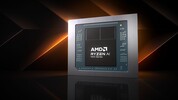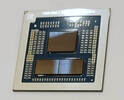AMD Ryzen AI Max 390 vs AMD Ryzen 9 7940HX vs AMD Ryzen 9 7840HX
AMD Ryzen AI Max 390
► remove from comparison
The AMD Ryzen AI Max 390 is a powerful Strix Halo family processor that debuted in January 2025. The APU comes equipped with 12 Zen 5 CPU cores running at up to 5.0 GHz, the 32 CU RDNA 3+ Radeon 8050S graphics adapter and the 50 TOPS XDNA 2 neural engine. Other noteworthy features include PCIe 4, USB 4 and LPDDR5x-8000 RAM support and a whole lot of L3 cache.
Architecture and Features
Unlike it is with Strix Point, Strix Halo parts are powered by Zen 5 cores - no Zen 5c here. It's not clear if this is the desktop Zen 5 implementation with full AVX512 throughput or the mobile one. According to AMD, Zen 5 delivers a 16% IPC improvement over Zen 4 thanks to branch prediction improvements and other refinements.
Elsewhere, the AI Max chip supports RAM as fast as LPDDR5x-8000, and is natively compatible with USB 4 (and therefore Thunderbolt). It has PCIe 4.0 support for a throughput of 1.9 GB/s per lane, just like its 8000 series predecessors had. The integrated XDNA 2 NPU delivers up to 50 INT8 TOPS for accelerating various AI workloads.
Performance
Its CPU performance should be about 10% higher than that of the Ryzen AI 9 HX 370 and HX 375 due to the AI Max chip's higher TDP power target and lack of cut-down Zen 5c cores.
Graphics
The Radeon 8050S sports 32 RDNA 3+ architecture CUs (2048 unified shaders) that could see it competing with lower mid-range desktop graphics cards like the Radeon RX 7700 XT. This GPU will undoubtedly run any game at 1080p on Ultra, however, the ultimate question is whether or not the cooling solution of the laptop will be powerful enough to let the iGPU shine.
Naturally, the Radeon is capable of driving four SUHD 4320p60 monitors. It can also efficiently encode and decode the most popular video codecs including AVC, HEVC, VP9 and AV1. The latest addition to that list, the VVC codec, is not supported unlike it is with Intel Lunar Lake chips.
Power consumption
The AI Max 390 can eat up to 120 W depending on the system and its TDP power targets, with 45 W named as the minimum TDP.
The 4 nm TSMC process that the CPU cores are built with make for decent, as of Jan 2025, energy efficiency.
AMD Ryzen 9 7940HX
► remove from comparison
The AMD Ryzen 9 7940HX is a high-end notebook processor from the Dragon Range series with 16 cores and hyperthreading (SMT), which means it can process up to 32 threads simultaneously. The CPU uses the current Zen 4 architecture for the 16 cores and clocks these from 2.4 GHz (base clock) up to 5.2 GHz (single-core boost). The CPU offers 16 MB L2 cache and 64 MB L3 cache (i.e. a total of 80 MB cache). The 7940HX consists of three chiplets, two CCD clusters with 8 CPU cores each made with a 5nm node (71mm²) and one IO die on 6nm (122mm²), are all manufactured at TSMC's fabs.
The performance of the Ryzen 9 should be comparable to a Core i9-13900HX (24 hybrid cores, max 5.4 GHz) in the top range of mobile processors from 2024. AMD itself advertises a clear lead over the old Ryzen 9 6900HX (8 Zen 3 cores, 4.9 GHz), which can be explained by the additional cores, improved architecture and higher frequencies. Compared to the top model, the Ryzen 9 7945HX, the 7940HX is slightly lower clocked.
The chip also integrates 4x USB 3.2 Gen2 (10 Gbps) ports (no USB 4), 28 PCIe 5.0 lanes (for GPUs and SSDs), a dual-channel DDR5-5200 memory controller and a small AMD Radeon 610M graphics card (2CUs, 400 - 2200 MHz).
The R9 7940HX is specified with 55 watts TDP and can be configured up to 75 watts (cTDP).
AMD Ryzen 9 7840HX
► remove from comparison
The AMD Ryzen 9 7840HX is a high-end notebook processor from the Dragon Range series with 12 cores and hyperthreading (SMT), which means it can process up to 24 threads simultaneously. The CPU uses the current Zen 4 architecture for the 12 cores and clocks these from 2.9 GHz (base clock) up to 5.1 GHz (single-core boost). The CPU offers 12 MB L2 cache and 64 MB L3 cache (i.e. a total of 76 MB cache). The 7840X consists of three chiplets, two CCD clusters with a maximum of 8 CPU cores on 5nm (71mm²) and one IO die on 6nm (122mm²) which are all manufactured by TSMC.
The performance of the Ryzen 9 should be significantly faster than the old Ryzen 9 6980HX (top model Rembrandt H, 8 cores, max 5 GHz). This is achieved by the additional cores, higher clock rate and improved architecture. Compared to the one year older Ryzen 9 7845HX, the 7840HX is clocked 100 MHz lower.
The chip also integrates 4x USB 3.2 Gen2 (10 Gbps) ports (no USB 4), 28 PCIe 5.0 lanes (for GPUs and SSDs), a dual-channel DDR5-5200 memory controller and a small AMD Radeon 610M graphics card (2CUs, 400 - 2200 MHz).
The R9 7840HX is specified with 55 watts TDP and can be configured from 45 to 75 watts (cTDP).
| Model | AMD Ryzen AI Max 390 | AMD Ryzen 9 7940HX | AMD Ryzen 9 7840HX | ||||||||||||||||||||||||||||||||||||||||||||||||||||
| Codename | Strix Halo | Dragon Range-HX (Zen 4) | Dragon Range-HX (Zen 4) | ||||||||||||||||||||||||||||||||||||||||||||||||||||
| Series | AMD Strix Halo/Point (Zen 5/5c, Ryzen AI 300) | AMD Dragon Range (Zen 4, Ryzen 7X4X/8X4X) | AMD Dragon Range (Zen 4, Ryzen 7X4X/8X4X) | ||||||||||||||||||||||||||||||||||||||||||||||||||||
| Series: Dragon Range (Zen 4, Ryzen 7X4X/8X4X) Dragon Range-HX (Zen 4) |
|
|
| ||||||||||||||||||||||||||||||||||||||||||||||||||||
| Clock | 3200 - 5000 MHz | 2400 - 5200 MHz | 2900 - 5100 MHz | ||||||||||||||||||||||||||||||||||||||||||||||||||||
| L2 Cache | 12 MB | 16 MB | 12 MB | ||||||||||||||||||||||||||||||||||||||||||||||||||||
| L3 Cache | 64 MB | 64 MB | 64 MB | ||||||||||||||||||||||||||||||||||||||||||||||||||||
| Cores / Threads | 12 / 24 12 x 5.0 GHz AMD Zen 5 | 16 / 32 16 x 5.2 GHz AMD Zen 4 | 12 / 24 12 x 5.1 GHz AMD Zen 4 | ||||||||||||||||||||||||||||||||||||||||||||||||||||
| TDP | 55 Watt | 55 Watt | 55 Watt | ||||||||||||||||||||||||||||||||||||||||||||||||||||
| Technology | 4 nm | 5 nm | 5 nm | ||||||||||||||||||||||||||||||||||||||||||||||||||||
| Socket | FP11 | FL1 | FL1 | ||||||||||||||||||||||||||||||||||||||||||||||||||||
| Features | LPDDR5x-8000 RAM, PCIe 4, USB 4, XDNA 2 NPU (50 TOPS), SMT, AES, AVX, AVX2, AVX512, FMA3, MMX (+), SHA, SSE, SSE2, SSE3, SSSE3, SSE4.1, SSE4.2, SSE4A | DDR5-5200 RAM, PCIe 5, MMX, SSE, SSE2, SSE3, SSSE3, SSE4A, SSE4.1, SSE4.2, AVX, AVX2, AVX-512, BMI2, ABM, FMA, ADX, SMEP, SMAP, SMT, CPB, AES-NI, RDRAND, RDSEED, SHA, SME | DDR5-5200 RAM, PCIe 5, MMX, SSE, SSE2, SSE3, SSSE3, SSE4A, SSE4.1, SSE4.2, AVX, AVX2, AVX-512, BMI2, ABM, FMA, ADX, SMEP, SMAP, SMT, CPB, AES-NI, RDRAND, RDSEED, SHA, SME | ||||||||||||||||||||||||||||||||||||||||||||||||||||
| iGPU | AMD Radeon RX 8050S ( - 2800 MHz) | AMD Radeon 610M (400 - 2200 MHz) | AMD Radeon 610M (400 - 2200 MHz) | ||||||||||||||||||||||||||||||||||||||||||||||||||||
| Architecture | x86 | x86 | x86 | ||||||||||||||||||||||||||||||||||||||||||||||||||||
| Announced | |||||||||||||||||||||||||||||||||||||||||||||||||||||||
| Manufacturer | www.amd.com | www.amd.com | www.amd.com | ||||||||||||||||||||||||||||||||||||||||||||||||||||
| L1 Cache | 1 MB | 768 KB | |||||||||||||||||||||||||||||||||||||||||||||||||||||
| Transistors | 9900 Million | 9900 Million | |||||||||||||||||||||||||||||||||||||||||||||||||||||
| max. Temp. | 100 °C | 100 °C |
Benchmarks
Average Benchmarks AMD Ryzen AI Max 390 → 100% n=2
Average Benchmarks AMD Ryzen 9 7940HX → 93% n=2
Average Benchmarks AMD Ryzen 9 7840HX → 89% n=2
* Smaller numbers mean a higher performance
1 This benchmark is not used for the average calculation













